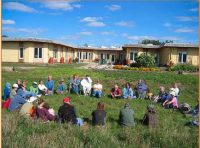
I recently had the opportunity to host a conversation about community with a unique group of my neighbors: the residents of Whole Village (www.wholevillage.org)—an intentional community and ecovillage located in Caledon, Ontario—whose residents have a shared commitment to creating a community that is dedicated to sustainable living. The members of Whole Village own and operate a 190-acre organic farm. The farm’s produce is sold through the Whole Village CSA as well as at several local area farmers markets.
About Whole Village
Greenhaven is the beautiful, cooperatively-owned home that sits at the heart of Whole Village. It includes 11 private apartments/suites that are all built around a common living, dining, and kitchen area. The home’s design incorporates many eco-friendly design elements. In addition to making the space welcoming, comfortable, and functional, Greenhaven’s design helps realize residents’ shared commitment to shift to “living lightly on the earth” by incorporating renewable energy elements and encouraging less consumption by living together.
Whole Village residents share leadership, community responsibilities, housekeeping chores, and financial commitments. Decisions are made within the community using a consensus-based decision-making process that includes weekly house meetings and annual retreats where all aspects of community life are discussed.
Eating together is the norm at Whole Village and communal dinners are held most evenings. Most of the vegetables that are consumed are produced on the property. Responsibility for cooking and clean-up is shared by residents according to a rotating roster of cooks and clean-up crews.
Whole Village residents nurture connections with the broader Caledon community by hosting concerts, seasonal celebrations, and educational events—such as permaculture workshops—for school groups as well as the general public. They have also collaborated on specific environmental stewardship projects with the Credit Valley Conservation Authority, and community members also actively participate in local fairs and eco-educational events throughout the region.
Exploring the Meaning of Community at Whole Village
As the host and documenter of this conversation I was curious: how would the experience of being part of an intentional community and ecovillage lead to experiences of community that are similar or different from my own, more traditional, experience of community? Highlights from this rich conversation are shared below.
Community: A Sense of Belonging
After members recalled and shared powerful personal experiences of community with each other, we were able to identify several commonalities across this rich diversity of individual experiences. One dominant theme that quickly emerged was that of feeling connected and understood: a sense of belonging. People noted that this sense of belonging was a source of real inspiration which could be strengthened when it also included a commitment to a common goal that people were willing and able to work towards together.
Living Cooperatively: A New Paradigm for Happiness
Whole Village members noted that living in community creates different opportunities for happiness than what is often the norm. They felt that most people’s experience of community is rooted in the dominant North American culture of consumerism and individualism. This paradigm suggests that personal happiness is something that can be purchased through material things or experiences. Whole Village members shared that being in community offers an alternative route to happiness. As one resident noted, “There is much more available to me when I’m living in community than when I am isolated,” and another commented, “Being in community eliminates that sense of greed and encourages us to rely on others. Living with others returns us to the good. Happiness and fulfillment come from finding a shared way of being together.”
Beyond the simple joy of being together, members stressed how happiness in community was also linked to working together to achieve shared goals, “not in a hierarchy, but united by a shared vision.” The joy of discovering and benefiting from the knowledge and ability of others and appreciating the education that comes from sharing knowledge was also seen as one of the real benefits of living in community.
Community: Not Always Utopia
In spite of the benefits of community, living together is not always ideal or a utopia. Because the members of Whole Village farm together—which can be exhausting—and also live together, they noted that they can “bump up against each other” and that their diversity can lead to conflicts. This can make it challenging for “everyone to stay in heart.” As one member noted, “We all join the community and bring our own baggage…and we can react to this. We also have to address these dynamics in the community.”
Intentional Community’s Unique Perspective on Community
Reflecting on the unique experience of community for Whole Village members, some noted that the decision to become part of an intentional community created specific challenges. For some, the move to Whole Village meant leaving an urban centre and adjusting to life within a rural setting. For others, becoming a Whole Village member involved embracing a new mindset and an alternative, more ecologically-friendly way of living that requires considerable “un-learning.” As one member said, “I had to fight my own cultural programming in order to embrace living communally.”
Another unique dimension of choosing to live in an intentional community, and adopting the alternative lifestyle of the Whole Village ecovillage, is explaining and managing the range of reactions that this decision generated within members’ extended families.
Members also spoke about the multiple commitments that they each needed to juggle in terms of their obligations to living in intentional community. For those who were working outside the village, it was sometimes challenging to manage professional job responsibilities alongside their commitments to the community. One person explained, “There is a need to always find the balance between advancing community projects versus our own one-off projects.” As well, the day-to-day complexities of maintaining Whole Village—as both an intentional community and an ecovillage—requires Whole Village members to pay attention to several important dimensions of work simultaneously. These include:
● Commitment to a Shared Vision—Members must share and maintain a commitment to living and working towards sustainability;
● Assembling the Right Mix of Residents—Having a shared vision is essential but not sufficient to sustain an ecovillage; it is also important that members have a diversity of skills, knowledge, and resources;
● Tending to Interpersonal Dynamics—Attention must be paid to how members are with one another, and learning how to work with each other’s idiosyncrasies; and,
● Ensuring Financial Viability—Members must also pay attention to the economics of the community and ensure that adequate financing has been secured to sustain the community.
These complexities were articulated in a comment from one member who said, “As we learn more about permaculture it is difficult to reconcile the long-term plans this requires with the time and energy that goes into orienting new people about how we work and the rules we’ve set for how to work and live together.”
In spite of the bigger commitment to relationship-building that living within an intentional community requires, members noted that living this way also creates opportunities for more in-depth learning. One member observed, “I’ve learned to talk more and I have been able to build relationships; before, I didn’t really know anyone.”
The Purpose of Community: Realizing that More Is Possible Together
As this conversation drew to a close, time was spent reflecting on what people discerned as the purpose and job of community. One point of consensus is that “we are happiest when we are altruistic” and that in community, “we have the ability to achieve a higher standard or quality of life.” One person noted, “I believe that we are all interconnected, and so the more I help and care for others, the more I am contributing to a positive change and can ‘get the ball rolling’ towards a better life.”
The group agreed that another central job of community is its unique role in supporting each of us to discover how to live more holistically and more authentically. One way that members observe this happens is that “living in community makes it harder to live behind masks.” Several people shared that “in community, when people accept you as you truly are, it challenges you and holds you accountable to strive to be authentic.” And “when you discover that people love you in your authenticity, it enables you to be more present.” A metaphor offered some time ago by Laird Schaub was shared to illustrate this central role of community: “I remember him (Laird) saying that the work of community is the work of world peace. This reminds me that when we are able to create peace between us today, in our relationships with one other, we are making a contribution towards our deep hope for shared peace in the world.”
Sylvia Cheuy is a Director with Tamarack—An Institute for Community Engagement. She is a resident of Caledon, Ontario and a neighbor to the folks at Whole Village.















